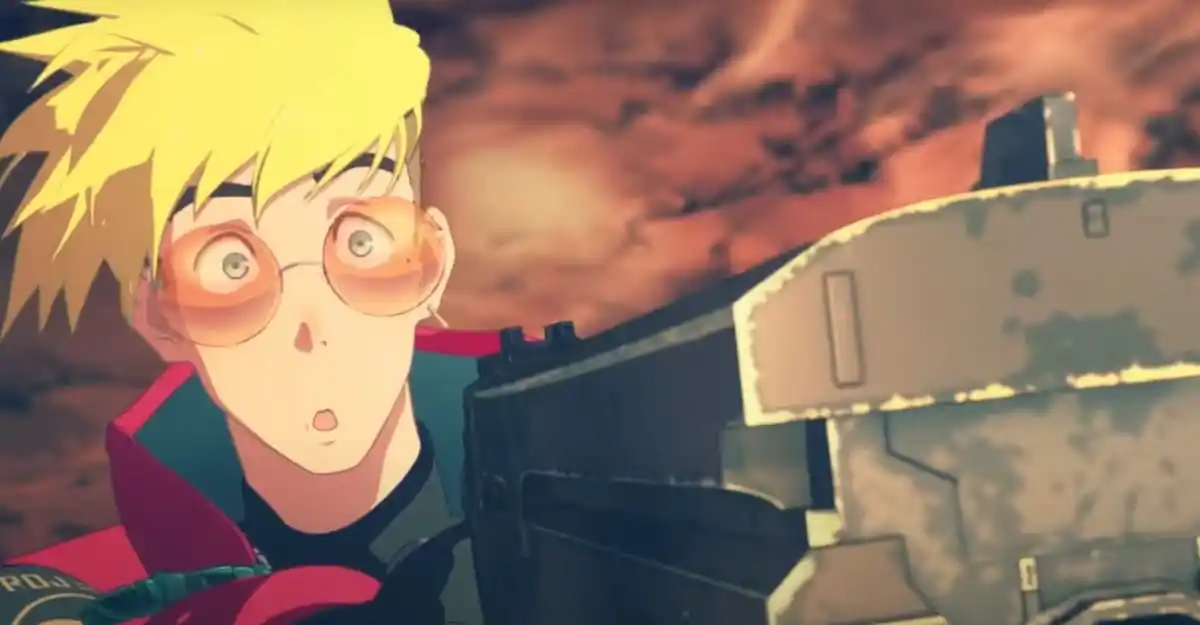We seem to be entering a time of many anime reboots and returns. 2022 had quite a few: Urusei Yatsura brought a classic ’80s series into the modern day with the help of one hell of an OP. Tokyo Mew Mew Mew is an update of a beloved series from the early 2000s, as is 2021’s Shaman King. So far, 2023 has two big headliners. One is LIDENFILM’s somewhat controversial return to Rurouni Kenshin. The other is an adaptation of the 1998 classic Trigun, titled Trigun Stampede, courtesy of Orange, the CG-specialized studio behind Beastars. But there’s understandably been some confusion: Is Trigun Stampede a reboot? A prequel? A sequel?
The 1998 Trigun series was based on a manga by Yasuhiro Nightow and originally aired from 1995 to 1997. Trigun follows Vash the Stampede, a wanted man who’s known all around the desert planet of No Man’s Land as the “Humanoid Stampede” for the havoc which always seems to follow in his wake. He continually bumps into Meryl Stryfe and Milly Thompson, insurance agents who specialize in disasters.
Is Trigun Stampede a reboot?
Trigun Stampede is, indeed, a reboot. But don’t expect a mere rehashing of the 1998 series you already know. The new anime shakes up the original significantly, including the order in which it presents its narrative, its more serious and sincere tone, and even the histories and existence of some of its characters. In fact, it may be more helpful to think of Trigun Stampede as a reimagining of the Trigun series, similar to the relationship between the Evangelion series and its later movie reboots.
In a press release from 2022, quoted by Comicbook.com, director Kenji Muto talks about the discussions that occurred when deciding on Trigun Stampede‘s tone:
Rather than simply tracing the original manga that started 27 years ago, we wanted to define the meaning of creating this work as an entertainment piece in this day and age. So Nightow-sensei, producers, and I talked again and again. In the far distant future, a spaceship lands on an unexplored planet called No Man’s Land. Reminiscent of the American Old West, the residents of No Man’s Land, who are the immigrants from Earth, create a new, free world where myriads of cultures and religions coexist, with guns in their hands.
One of the most controversial differences is that Milly Thompson—a main character and a fan-favorite—is no where to be found in the available materials for Trigun Stampede. She has been replaced by Roberto De Niro, who is Meryl’s senior partner. So Meryl’s lost her authority. And Roberto and Meryl work as reporters, not insurance agents. Roberto, by the way, sucks. I’ll dig into him real good in my review.
Following my Evangelion analogy, adding characters or reimagining their roles isn’t unheard of in this kind of reboot. But getting rid of a character? Hot take, Orange, if true.
There are some tonal differences between the original Trigun and the new series, as well. As you might also be able to guess from the Muto quote above, Trigun Stampede immediately establishes itself as a kind of space epic. You find out about a whole lot of things in episode 1 that you don’t learn in the 1998 version until way later. You don’t get everything, but you get a lot—especially when you compare it to the 1998 series, where you’re not even explicitly told that the guy in the red coat is the real Vash the Stampede for a hot second. Like, many episodes. Point is, Stampede lays its stakes bare immediately.
To perhaps go along with that, Vash himself acts more sincere and less goofy than his 1998 counterpart. It’s not that the 1998 Vash isn’t sincere or a big softie, of course. It’s that the sincerity (or moments of Shounen Coolness) are healthily interspersed with Vash being ridiculous. The Stampede Vash is a bit more of a serious, earnest Vash.
So, yes, it’s a reboot. But don’t expect Milly to be there ordering a banana sundae within the first few minutes. Based on its first episode, Trigun Stampede sends a clear message: We’re in for a very different ride than the one Madhouse took us on 25 years ago.
Image credit: Yasuhiro Nightow, SHONENGAHOSHA / TRIGUN STAMPEDE Project










Published: Jan 6, 2023 12:03 pm